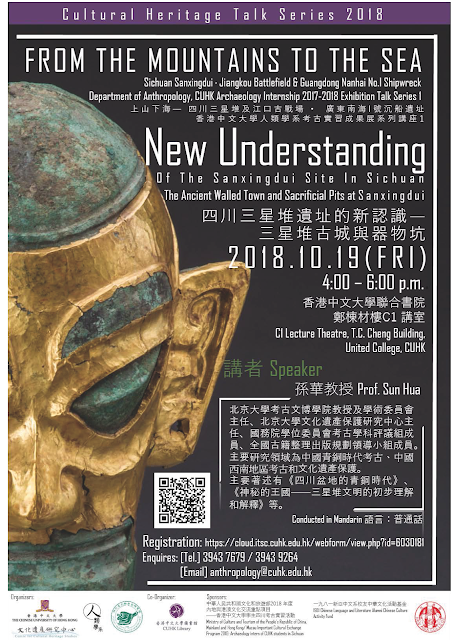Sichuan Sanxingdui • Jiangkou Battlefield & Guangdong Nanhai No.I Shipwreck
Archaeology Internship 2017-2018 Exhibition
上山下海 —— 四川三星堆及江口古戰場.廣東南海I號沉船遺址:香港中文大學人類學系考古實習成果展
Date: 15 Oct - 20 Dec 2018
Venue: University Library, The Chinese University of Hong Kong
Only through the “touching the ground” experience, can we understand the meaning of material culture in the past and explain to our contemporaries why we need to care about archaeological ruins. Our students learned a wide range of fieldwork skills and techniques through these meaningful archaeological internships. More important, the hands-on experience provides a great chance to them for better understanding the Bronze Age civilization in Sichuan and the Jiangkou sunken treasure legend. To team up with the underwater archaeology group, we want to present not only the fascinating archaeological experience “From the Mountains (Sichuan) to the Sea (Guangdong)” but also provide the general public some reflections inspired by these internships such as the variety and diversity of ancient civilizations in China and the role of Guangdong and Sichuan on the ancient Silk Roads. You are all cordially invited to visit this upcoming exhibition and attend the following activities.
(1) Opening Ceremony Online Registration
Date:19 Oct 2018 (Fri)
Time:2:30 pm
Venue:University Library, The Chinese University of Hong Kong
(2) Centre for Cultural Heritage Studies Talk Series 2018/ Exhibition Talk Series 1 Online Registration
Title: New Understanding of the Sanxingdui Site in Sichuan - The Ancient Walled Town and Sacrificial Pits at Sanxingdui (in Putonghua) 四川三星堆遺址的新認識 - 三星堆古城與器物坑 (普通話)
Speaker: Prof. SUN Hua (School of Archaeology and Museology, Peking University)
Date:19 Oct 2018 (Fri)
Time: 4:00-6:00 pm
Venue: C1 T.C. Cheng Building, United College
Abstract:四川廣漢市的三星堆遺址是古代蜀國的中心都城,這裡曾有著名的三星堆“祭祀坑”的發現。隨著成都平原青銅時代考古的快速發展,三星堆遺址考古工作的全面推進,以及兩個器物坑文物復原研究的新成果,我們對三星堆遺址、三星堆文化和三星堆古代國家也有了全新的認識。講座分前後兩部分,第一部分是從三星堆遺址入手,對三星堆古城的演變、佈局、規劃思想及其影響提出了新看法;第二部分是從三星堆“祭祀坑”的器物入手,結合新的考古發現,對三星堆國家的族群構成、統治集團、宗教觀念和社會狀態進行新的闡釋。
Speaker bio:孫華,北京大學考古文博學院教授、北京大學考古文博學院學術委員會主任、北京大學文化遺產保護研究中心主任、國務院學位委員會考古學科評議組成員、全國古籍整理出版規劃領導小組成員。主要研究領域為中國青銅時代考古、中國西南地區考古和文化遺產保護。主要著述有《四川盆地的青銅時代》、《神秘的王國――對三星堆文明的初步理解和解釋》等。
Organizers 主辦:
Department of Anthropology, The Chinese University of Hong Kong 香港中文大學人類學系Centre for Cultural Heritage Studies 文化遺產研究中心
Sichuan Archaeology Research Institute, China 四川省文物考古研究院
Co-organizer 協辦: University Library, The Chinese University of Hong Kong 香港中文大學圖書館
Archaeology Internship 2017-2018 Exhibition
上山下海 —— 四川三星堆及江口古戰場.廣東南海I號沉船遺址:香港中文大學人類學系考古實習成果展
Venue: University Library, The Chinese University of Hong Kong
Only through the “touching the ground” experience, can we understand the meaning of material culture in the past and explain to our contemporaries why we need to care about archaeological ruins. Our students learned a wide range of fieldwork skills and techniques through these meaningful archaeological internships. More important, the hands-on experience provides a great chance to them for better understanding the Bronze Age civilization in Sichuan and the Jiangkou sunken treasure legend. To team up with the underwater archaeology group, we want to present not only the fascinating archaeological experience “From the Mountains (Sichuan) to the Sea (Guangdong)” but also provide the general public some reflections inspired by these internships such as the variety and diversity of ancient civilizations in China and the role of Guangdong and Sichuan on the ancient Silk Roads. You are all cordially invited to visit this upcoming exhibition and attend the following activities.
(1) Opening Ceremony Online Registration
Date:19 Oct 2018 (Fri)
Time:2:30 pm
Venue:University Library, The Chinese University of Hong Kong
(2) Centre for Cultural Heritage Studies Talk Series 2018/ Exhibition Talk Series 1 Online Registration
Speaker: Prof. SUN Hua (School of Archaeology and Museology, Peking University)
Date:19 Oct 2018 (Fri)
Time: 4:00-6:00 pm
Venue: C1 T.C. Cheng Building, United College
Abstract:四川廣漢市的三星堆遺址是古代蜀國的中心都城,這裡曾有著名的三星堆“祭祀坑”的發現。隨著成都平原青銅時代考古的快速發展,三星堆遺址考古工作的全面推進,以及兩個器物坑文物復原研究的新成果,我們對三星堆遺址、三星堆文化和三星堆古代國家也有了全新的認識。講座分前後兩部分,第一部分是從三星堆遺址入手,對三星堆古城的演變、佈局、規劃思想及其影響提出了新看法;第二部分是從三星堆“祭祀坑”的器物入手,結合新的考古發現,對三星堆國家的族群構成、統治集團、宗教觀念和社會狀態進行新的闡釋。
Speaker bio:孫華,北京大學考古文博學院教授、北京大學考古文博學院學術委員會主任、北京大學文化遺產保護研究中心主任、國務院學位委員會考古學科評議組成員、全國古籍整理出版規劃領導小組成員。主要研究領域為中國青銅時代考古、中國西南地區考古和文化遺產保護。主要著述有《四川盆地的青銅時代》、《神秘的王國――對三星堆文明的初步理解和解釋》等。
Organizers 主辦:
Department of Anthropology, The Chinese University of Hong Kong 香港中文大學人類學系Centre for Cultural Heritage Studies 文化遺產研究中心
Sichuan Archaeology Research Institute, China 四川省文物考古研究院
Co-organizer 協辦: University Library, The Chinese University of Hong Kong 香港中文大學圖書館










